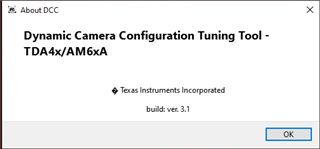Tool/software:
Hello Ti experts,
I am working on DCC tuning with the IMX462 Arducam camera (https://www.arducam.com/2mp-imx462-color-ultra-low-light-starvis-camera-module-with-141h-wide-angle-m12-lens-for-raspberry-pi.html). I successfully did the AWB, AE, EE, and colour correction, and the image quality improved a bit, even though the AWB is complicated to do correctly.
But as far as the IMX462 is a low-light sensor with amazing capabilities, I wanted to push the borders, and try to add Gamma correction and WDR+CFA, but in the tool, this is not available for RAW10, only RAW12+. I am using the DCC tool build version 3.1  . Maybe that is the problem?
. Maybe that is the problem?
The reason I need WDR is that in case of a bright object in the image (for example, a window in our classroom or a light bulb), the object itself and area around it influence the image quality and brightness a lot, the image becomes dark and with a big white blob around the window. If there is any advice on how to fix that without WDR, I would be glad!
Also, maybe you can recommend a lightbox that can be used for AWB calibration, because it is really hard to find one with a controllable light in the specified range.
Regards,
Mykola


